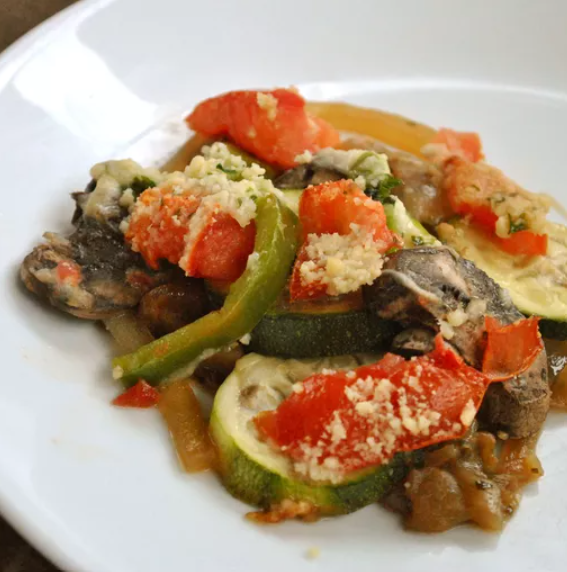
Introduction: Indulge in the savory flavors of France with this classic Ratatouille recipe. Bursting with vibrant vegetables and aromatic herbs, Ratatouille is a dish that embodies the essence of Mediterranean cuisine. Paired perfectly with crusty bread, this hearty meal is not only satisfying but also nutritious. Whether you’re a seasoned chef or a culinary novice, this step-by-step guide will help you create a mouthwatering Ratatouille that will tantalize your taste buds and impress your guests. Let’s dive into the ingredients and instructions to bring this French masterpiece to your dinner table.
Ingredients:
- 1 large eggplant, diced
- 2 medium zucchinis, sliced
- 1 large onion, chopped
- 2 bell peppers (red and yellow), diced
- 4 cloves garlic, minced
- 4 ripe tomatoes, diced
- 2 tablespoons tomato paste
- 1 tablespoon fresh basil, chopped
- 1 tablespoon fresh thyme leaves
- 1 tablespoon fresh parsley, chopped
- Salt and pepper to taste
- Olive oil for cooking
- Crusty bread for serving
Instructions:
- Prepare the Vegetables:
- Start by dicing the eggplant into bite-sized pieces. Place them in a colander, sprinkle with salt, and let them sit for about 20 minutes to draw out excess moisture. Rinse and pat dry with paper towels.
- Slice the zucchinis into rounds, chop the onion, dice the bell peppers, mince the garlic, and dice the tomatoes. Keep each vegetable separate for now.
- Sauté the Vegetables:
- In a large skillet or Dutch oven, heat a tablespoon of olive oil over medium heat. Add the onions and garlic, and sauté until softened and fragrant, about 3-4 minutes.
- Add the diced eggplant to the skillet and cook until it starts to brown, stirring occasionally, about 5-6 minutes.
- Next, add the bell peppers and zucchinis to the skillet. Cook for another 5 minutes until the vegetables are tender but still slightly crisp.
- Simmer with Tomatoes and Herbs:
- Stir in the diced tomatoes and tomato paste, combining everything well. Allow the mixture to simmer over low heat for about 10-15 minutes, until the flavors meld together and the sauce thickens slightly.
- Season the Ratatouille with chopped basil, thyme, parsley, salt, and pepper. Taste and adjust seasoning if necessary.
- Serve with Crusty Bread:
- Once the Ratatouille is ready, remove it from the heat and let it sit for a few minutes to cool slightly.
- Serve the Ratatouille warm, accompanied by slices of crusty bread for dipping and sopping up the flavorful sauce.
Serving Tips:
- Garnish with Fresh Herbs: Before serving, sprinkle some freshly chopped parsley or basil on top of the Ratatouille for an extra burst of flavor and a touch of color.
- Pair with Protein: While Ratatouille is a flavorful vegetarian dish on its own, you can elevate it further by serving it alongside grilled chicken, fish, or even a poached egg for added protein and a well-rounded meal.
- Serve with Grains: For a more filling meal, consider serving Ratatouille over cooked grains like rice, quinoa, or couscous. The grains will soak up the delicious sauce and complement the vegetables perfectly.
- Add a Splash of Balsamic Vinegar: Drizzle a small amount of aged balsamic vinegar over the Ratatouille just before serving to add a hint of sweetness and acidity, enhancing the overall flavor profile of the dish.
- Accompany with Wine: Pair your Ratatouille with a glass of your favorite wine, such as a light-bodied red like Pinot Noir or a crisp white like Sauvignon Blanc, to complement the dish’s Mediterranean flavors and create a delightful dining experience.
Storage Tips:
- Refrigerate Promptly: If you have leftovers, allow the Ratatouille to cool to room temperature before transferring it to an airtight container. Refrigerate it promptly to prevent bacterial growth.
- Consume Within 3-4 Days: Ratatouille can be stored in the refrigerator for up to 3-4 days. Make sure to reheat it thoroughly before serving.
- Freeze for Longer Storage: If you don’t plan to consume the leftovers within a few days, consider freezing them instead. Portion the Ratatouille into freezer-safe containers or resealable bags, leaving some room for expansion, and freeze for up to 3 months.
- Thaw Properly: When ready to enjoy the frozen Ratatouille, transfer it to the refrigerator to thaw overnight. Reheat it gently on the stovetop or in the microwave until heated through.
- Revitalize Before Serving: If the Ratatouille seems a bit dry after reheating, add a splash of vegetable broth or water to rejuvenate the sauce and restore its original consistency. Adjust seasoning as needed before serving.
By following these serving and storage tips, you can ensure that your Ratatouille remains fresh, flavorful, and enjoyable for days to come.
Variations to customize your Ratatouille recipe:
- Ratatouille with Cheese: Add a layer of grated Parmesan, Gruyère, or goat cheese on top of the Ratatouille just before serving. Broil in the oven for a few minutes until the cheese is melted and bubbly for a decadent twist.
- Spicy Ratatouille: For a kick of heat, add diced jalapeños, red pepper flakes, or a dash of hot sauce to the Ratatouille during cooking. The spicy notes will add an exciting dimension to the dish.
- Mushroom Ratatouille: Enhance the earthy flavors by adding sliced mushrooms, such as cremini or button mushrooms, to the Ratatouille. Sauté them with the other vegetables until tender and juicy.
- Grilled Ratatouille: Instead of sautéing the vegetables, grill them on a barbecue or grill pan for a smoky flavor. Brush the vegetables with olive oil and season with salt and pepper before grilling until charred and tender.
- Protein-Packed Ratatouille: Incorporate protein-rich ingredients like chickpeas, lentils, or tofu into the Ratatouille for a heartier meal. Simply add them along with the vegetables during cooking or serve the Ratatouille over a bed of cooked beans or lentils.
- Caponata-Inspired Ratatouille: Take inspiration from Sicilian cuisine by adding capers, olives, and a splash of balsamic vinegar to the Ratatouille. These briny and tangy ingredients will add complexity and depth of flavor to the dish.
- Herbaceous Ratatouille: Experiment with different herbs to elevate the Ratatouille’s flavor profile. Try adding rosemary, oregano, marjoram, or cilantro along with or in place of the traditional herbs for a fresh and aromatic twist.
- Ratatouille Stuffed Peppers: Hollow out bell peppers and stuff them with Ratatouille mixture before baking until the peppers are tender and the filling is heated through. Top with cheese for an extra indulgent variation.
- Curried Ratatouille: Infuse the Ratatouille with warm spices like curry powder, turmeric, and cumin for an exotic twist. Serve it with naan bread or basmati rice for a fusion of Mediterranean and Indian flavors.
- Ratatouille Pasta Sauce: Blend leftover Ratatouille into a smooth sauce and toss it with cooked pasta for a quick and satisfying meal. Add some fresh herbs and grated cheese on top for extra flavor.
These variations offer endless possibilities to customize your Ratatouille according to your taste preferences and culinary creativity. Experiment with different ingredients and techniques to create a dish that is uniquely yours!
Frequently Asked Questions (FAQs) about Ratatouille along with their answers:
- What is Ratatouille? Ratatouille is a traditional French Provençal vegetable dish originating from Nice. It typically consists of a medley of sautéed or roasted vegetables, such as eggplant, zucchini, bell peppers, onions, and tomatoes, seasoned with herbs and spices.
- Is Ratatouille vegan? Yes, Ratatouille is inherently vegan as it is made solely from plant-based ingredients. It’s a popular choice for vegans and vegetarians due to its flavorful and nutrient-rich profile.
- Can I make Ratatouille ahead of time? Yes, Ratatouille can be made ahead of time and reheated before serving. In fact, its flavors often improve when allowed to meld together overnight in the refrigerator. Store it in an airtight container and reheat gently on the stovetop or in the microwave.
- What should I serve with Ratatouille? Ratatouille can be served as a standalone dish or as a side alongside grilled meats, fish, or poultry. It pairs well with crusty bread, rice, quinoa, or pasta for a more substantial meal. A glass of wine complements its Mediterranean flavors nicely.
- Can I freeze Ratatouille? Yes, Ratatouille can be frozen for longer-term storage. Allow it to cool completely before transferring it to freezer-safe containers or resealable bags. Freeze for up to 3 months. Thaw overnight in the refrigerator before reheating.
- How do I prevent Ratatouille from becoming mushy? To prevent Ratatouille from becoming mushy, make sure not to overcook the vegetables. Sauté them just until they are tender but still slightly crisp. Additionally, avoid stirring the Ratatouille too vigorously once all the vegetables are added to the pot to maintain their integrity.
- Can I customize Ratatouille to suit my taste preferences? Absolutely! Ratatouille is highly customizable. You can add or substitute vegetables, adjust the seasoning, or experiment with different herbs and spices to tailor the dish to your liking. It’s a versatile recipe that invites creativity in the kitchen.
- Is Ratatouille gluten-free? Yes, Ratatouille is naturally gluten-free as it does not contain any wheat, barley, or rye ingredients. However, if serving it with bread, make sure to choose a gluten-free option.
These FAQs cover common inquiries about Ratatouille, helping you understand and prepare this classic French dish with confidence and ease.
In conclusion, Ratatouille is not just a dish; it’s a culinary journey through the flavors of Provence, France. With its vibrant colors, rich aromas, and wholesome ingredients, Ratatouille embodies the essence of Mediterranean cooking. Whether enjoyed as a comforting weeknight meal or served as an elegant centerpiece at a dinner party, Ratatouille never fails to delight the senses and nourish the soul.
From its humble origins as a peasant dish to its modern-day status as a beloved classic, Ratatouille continues to captivate food enthusiasts around the world. With its versatility, Ratatouille invites creativity and experimentation, allowing home cooks to personalize the recipe to suit their taste preferences and dietary needs.
